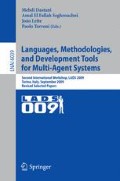Abstract
In this paper, we introduce an agent planner architecture that can reduce the basic artifacts of agent planning paradigms, semantic services and business process languages into a common workflow model. These artifacts are then executed by means of a workflow component that the architecture includes. By having a workflow component in an agent infrastructure, various agent programming paradigms including different planning approaches as well as different workflow definition languages can be executed on the same agent platform. To illustrate our ideas, we focus on the reduction of plans to the workflow model. To explicate the reduction mechanism, we have preferred to use HTN which is a widely known planning approach in multi-agent domain. Based on the semantics that we have defined for our workflow and HTN models, we have given an algorithm for transformation from HTN to workflow model.
Access this chapter
Tax calculation will be finalised at checkout
Purchases are for personal use only
Preview
Unable to display preview. Download preview PDF.
References
Andrews, T., Curbera, F., Dholakia, H., Goland, Y., Klein, J., Leymann, F., Liu, K., Roller, D., Smith, D., Thatte, S., Trickovicand, I., Weerawarana, S.: Business process execution language for web services v-1.1, W3C. Candidate recommendation (2003)
WfMC, Workflow management coalition workflow standard: Workflow process definition interface - XML process definition language (XPDL) (wfmc-tc-1025). Workflow Management Coalition, Lighthouse Point, (FL), Tech. rep. (2002)
Erol, K., Hendler, J., Nau, D.S.: Semantics for hierarchical task-network planning, University of Maryland, College Park, MD, USA, Tech. Rep. (1994)
Sycara, K., Williamson, M., Decker, K.: Unified information and control flow in hierarchical task networks. In: Working Notes of the AAAI 1996 workshop, Theories of Action, Planning, and Control (1996)
Sadiq, W., Orlowska, M.E.: Modeling and verification of workflow graphs. Technical Report No. 386, Department of Computer Science. The University of Queensland, Australia (1996)
Sirin, E., Parsia, B., Wu, D., Hendler, J.A., Nau, D.S.: HTN planning for web service composition using SHOP2. J. Web Sem. 1(4), 377–396 (2004)
Caire, G., Gotta, D., Banzi, M.: WADE: A software platform to develop mission critical applications exploiting agents and workflows. In: AAMAS (Industry Track), pp. 29–36 (2008)
Bellifemine, F., Bergenti, F., Caire, G., Poggi, A.: JADE - a java agent development framework. In: Multi-Agent Programming, pp. 125–147. Springer, US (2005)
Ekinci, E.E., Tiryaki, A.M., Gürcan, Ö., Dikenelli, O.: A planner infrastructure for semantic web enabled agents. In: Meersman, R., Tari, Z., Herrero, P. (eds.) OTM-WS 2007, Part I. LNCS, vol. 4805, pp. 95–104. Springer, Heidelberg (2007)
Dikenelli, O.: SEAGENT MAS platform development environment. In: AAMAS (Demos), pp. 1671–1672 (2008)
Çetin, Ö., Ekinci, E.E., Erdur, R.C., Dikenelli, O.: Executing semantic web services on a workflow based agent planner. In: ICSC, pp. 229–236 (2009)
Graham, J.R., Decker, K., Mersic, M.: DECAF - a flexible multi agent system architecture. Autonomous Agents and Multi-Agent Systems 7(1-2), 7–27 (2003)
Sycara, K.P., Paolucci, M., Velsen, M.V., Giampapa, J.A.: The RETSINA MAS infrastructure. Autonomous Agents and Multi-Agent Systems 7(1-2), 29–48 (2003)
van der Aalst, W.M.P.: The application of petri nets to workflow management. Journal of Circuits, Systems, and Computers 8(1), 21–66 (1998)
Sadiq, S.W., Orlowska, M.E., Sadiq, W., Foulger, C.: Data flow and validation in workflow modelling. In: ADC, pp. 207–214 (2004)
Sadiq, W., Orlowska, M.E.: Analyzing process models using graph reduction techniques. Inf. Syst. 25(2), 117–134 (2000)
Davis, J., Du, W., Shan, M.-C.: OpenPM: An enterprise process management system. IEEE Data Eng. Bull. 18(1), 27–32 (1995)
Du, W., Davis, J., Shan, M.-C.: Flexible specification of workflow compensation scopes. In: GROUP, pp. 309–316 (1997)
van der Aalst, W.M.P., ter Hofstede, A.H.M., Kiepuszewski, B., Barros, A.P.: Workflow patterns. Distributed and Parallel Databases 14(1), 5–51 (2003)
Author information
Authors and Affiliations
Editor information
Editors and Affiliations
Rights and permissions
Copyright information
© 2010 Springer-Verlag Berlin Heidelberg
About this paper
Cite this paper
Halaç, T.G., Çetin, Ö., Ekinci, E.E., Erdur, R.C., Dikenelli, O. (2010). Reducing Agent Plans to Workflows. In: Dastani, M., El Fallah Segrouchni, A., Leite, J., Torroni, P. (eds) Languages, Methodologies, and Development Tools for Multi-Agent Systems. LADS 2009. Lecture Notes in Computer Science(), vol 6039. Springer, Berlin, Heidelberg. https://doi.org/10.1007/978-3-642-13338-1_2
Download citation
DOI: https://doi.org/10.1007/978-3-642-13338-1_2
Publisher Name: Springer, Berlin, Heidelberg
Print ISBN: 978-3-642-13337-4
Online ISBN: 978-3-642-13338-1
eBook Packages: Computer ScienceComputer Science (R0)

